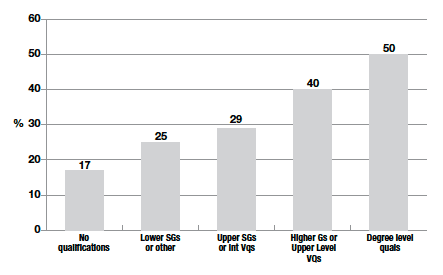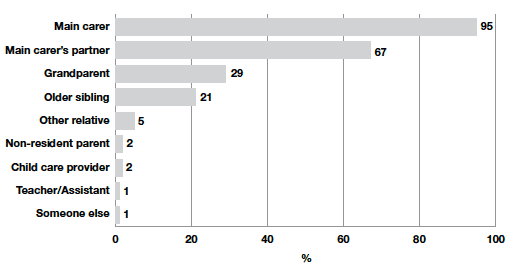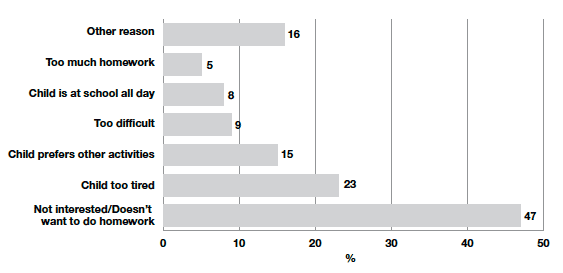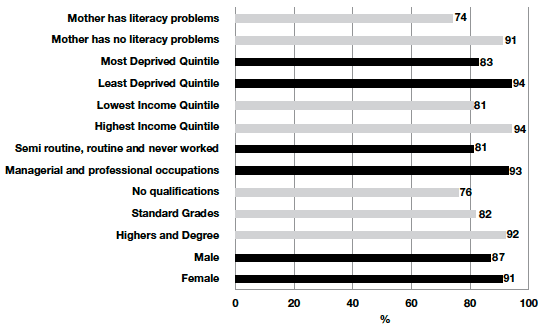Growing up in Scotland: early experiences of primary school
This research report highlights the key findings from the Growing up in Scotland early experiences study.
CHAPTER 5 PARENTAL INVOLVEMENT IN SCHOOL ACTIVITIES
5.1 Introduction
Parental involvement incorporates a broad range of activities including helping with homework, talking to teachers, attending school functions, and taking part in school governance. Here we specifically look at parental involvement in a range of activities or events at the child's school including attending a PTA meeting, or speaking to the headteacher as well as less formal parental involvement which occurs in the home.
It is well known that parental involvement in children's education from an early age is associated with educational achievement (for reviews see Desforges and Abouchaar 2003, Henderson and Mapp 2002, DCSF 2008). In addition, it has been found that the more intensely parents are involved, the more beneficial the achievement effects. This holds true for all types of parent involvement in children's learning and for all types and ages of students (Cotton and Wikelund 2001). Cotton and Wikelund (2001) stated that considerably greater achievement benefits have been noted by researchers when parent involvement is active - when parents work with their children in the home, but also when they attend and actively support school activities and when they help out in classrooms or on field trips, and so on.
Previous research has established a firm link between parental involvement and educational achievement and has demonstrated large differences between parents in their level of involvement in school activities (Desforges and Abouchaar 2003). Henderson and Mapp (2002) found that white, middle-class families in America are more likely to be involved at school than other types of families. Desforges and Abouchaar (2003) also reported that levels of involvement are positively related to social class and to maternal levels of education. Single parent status and problems with maternal psycho-social health (especially depression) have a negative impact on involvement. In Britain, DCSF (2008) reported that parents from Black British ethnic backgrounds are more involved in their child's school activities. They also reported that some groups of parents are less likely than average to feel very involved in children's education, for example parents from white or Asian backgrounds, lone parents, and parents who left education at a younger age.
Various barriers to parental involvement have been discussed in the literature, with the most commonly cited barrier being work commitments or other home-school scheduling conflicts ( DCSF 2008, Gonzalez-DeHass and Willems 2003). Other barriers reported by parents include childcare issues/the demands of other children ( DCSF 2008), being put off from school involvement by feeling put down by schools and teachers (Desforges and Abouchaar 2003), or not wanting to become involved because they question their ability to make a difference (Gonzalez-DeHass and Willems 2003). Conflicting beliefs about the ways in which parents should be involved in their children's schooling has also been cited as a potential barrier to increased involvement (Gonzalez-DeHass and Willems 2003).
The Scottish Government is committed to improving the involvement of parents in their children's education and in the work of schools themselves. The National Debate on Education in 2002 identified a need for increased parental involvement in their children's education. In response the Scottish Executive produced "Educating for Excellence" (2003) which identified the importance of improving partnerships between key stakeholders, in particular parents and schools. In 2006 the Scottish Parliament passed the Scottish Schools (Parental Involvement) Act which aims to help parents to be:
- involved with their child's education and learning
- welcomed as an active participant in the life of the school
- encouraged to express their views on school education and work in partnership with the school
The Act was introduced to help parents, carers and schools work together as partners in children's learning. It places duties on schools, local authorities and Scottish Government to make it easier for parents to become involved.
In 2009, Consumer Focus Scotland commissioned a survey of 1000 parents to look at the impact of the Act (Consumer Focus Scotland, 2009). They concluded that: "The increase in the number of parents who are members of Parent Councils, and other school-based parent bodies, is an endorsement of the change to reduce restrictions on membership and increase the flexibility of representative structures". They do however, caution that since the changes were only implemented a year or two before the survey was conducted, they are still in the early stages of development. However, some indication is provided that the new structures are attracting a wider group of parents than their predecessors (School Boards). This chapter allows us to look at parental involvement in these formal activities as well as less formal activities and events four years after the introduction of the Scottish Schools (Parental Involvement) Act.
5.2 Key findings
- 5% of parents had not participated in any activities or events at the child's school since the child started Primary 1.
- The most common activity for parents to be involved in was visiting their child's classroom, with 86% of parents reporting they had done this.
- 49% of parents participated in two or three activities or events at the child's school, while 29% attended three or four activities or events.
- Couple families and older mothers were more likely to have higher involvement than lone parents and younger mothers. Parents living in less deprived areas, those in higher occupational classes, in higher income groups, and with higher educational qualifications tended to report higher levels of involvement.
- Households where the respondent (usually the mother) worked part-time reported slightly higher involvement than those where the respondent worked full-time or was not working.
- 71% of Primary 1 pupils receive homework every or most days and virtually all parents (93%) said that their child always completed it.
- Almost all (95%) parents helped their child with their homework and 85% of parents said that it was easy to get their child to do their homework. The most common reason parents gave for finding it difficult to get the child to complete his or her homework, was that the child was not interested.
- Nine out of ten parents were confident helping their child with all subjects though confidence levels varied according to a number of demographic factors.
5.3 Prevalence of parental involvement in school activities
In this section we explore the prevalence of the different activities of parental involvement that were asked about in sweep 6 amongst families where the cohort child was in Primary 1 at that time. We also examine a composite index of these different activities.
The main carer was asked whether they or their partner had participated in nine activities since their child had started Primary 1. They were also asked to specify any other activities they had participated in other than the nine listed 11 . Table 5.1 shows the prevalence of each of these nine activities along with the prevalence of any other activities, and the proportion of parents who had participated in no activities since their child started Primary 1.
The most common activity that parent's had participated in was visiting their child's classroom (86% of parents said that they had done this), followed by attending a school event in which their child had participated (81%). Twenty-four per cent of parents had attended a Parent Council, PTA, or other such meeting while 19% of parents had volunteered in the classroom, school office, or library. Five per cent had not participated in any activities or events at the child's school since their child started Primary 1.
Table 5.1 Prevalence of activities or events attended
| Activity | Percentage of parents |
|---|---|
| Visited your child's classroom | 87 |
| Attended a school event in which your child participated | 81 |
| Spoken to the headteacher | 38 |
| Attended a school event in which your child did not participate | 30 |
| Volunteered and attended a trip or a school event | 28 |
| Attended a Parent Council, PTA, or other such meeting | 24 |
| Volunteered in the classroom, school office or library | 19 |
| Have volunteered for school activities but haven't been asked | 14 |
| Attended information meeting | 0 |
| Something else | 2 |
| None of these | 5 |
| Bases | |
| Weighted | 2486 |
| Unweighted | 2497 |
Note: Respondents could give multiple answers. Numbers will not total 100%.
Almost all parents (88%) reported attending more than one, and half (49%) had attended two or three events. The number of events attended was banded into four groups: 0-1, 2-3, 4-5 and 6 or more. Table 5.2 shows the distribution over these four groups.
Table 5.2 Number of activities or events attended, grouped
| Number of activities or events | Percentage of parents |
|---|---|
| 0-1 | 12 |
| 2-3 | 49 |
| 4-5 | 29 |
| 6 or more | 10 |
| Bases | |
| Weighted | 2486 |
| Unweighted | 2497 |
5.4 Differences in involvement by socio-demographics
The proportion of parents in each of the four groups of school involvement was compared across key sub-groups of interest. The number of children in the household did not appear to influence the parent's involvement in the study child's school events, with parents with only one child just as likely as parents with more children to attend four or more events.
Family type, however, was associated with higher parental involvement. Lone parents were less likely to attend four or more activities or events than couple families. This finding is displayed in Figure 5-A.
Younger mothers were also less likely to attend four or more events at the child's school. Thirty per cent of mothers aged 20 to 29 reported attending four or more events, compared with 39% of mothers aged 30 to 39 and 46% of mothers aged 40 or older.
Figure 5‑ A Parental Involvement (number of events or activities attended) by family type

Various measures of social disadvantage were associated with parental involvement. Those in less deprived areas were more likely to attend more events as were those parents in higher socio-economic occupation groups, those in higher income brackets, and parents in owner-occupied accommodation compared with social or private rented accommodation. Similarly, parents with higher educational qualifications were more likely to attend more events, as shown in Figure 5-B.
Figure 5‑ B Parental involvement (four or more events or activities attended) by educational qualifications

Respondents (in most cases the mother) in part-time employment (less than 35 hours per week) were the most likely to attend four or more events or activities at the childs school, with 42% reporting having done so compared with 38% of full-time workers and 35% of respondents who were not working at all. The distribution of the number of events attended by work status is shown in Figure 5-C.
Figure 5‑ C Parental involvement (number of events or activities attended) by work status

Finally, families in rural areas were more likely to have higher parental involvement in school activities than families in urban areas.
5.5 Multivariate analysis
In the previous section, relationships between various socio-demographics and parental involvement were examined in isolation. In this section we extend the analysis to look at these relationships while controlling for other factors. Multivariate logistic regression allows us to assess which factors are independently associated with lower parental involvement.
A description of the analysis and the full results are included in the technical appendix. Socio-economic occupation group, educational qualification and tenure were the only significant variables once other variables were controlled for. Work status and family type became non-significant in the presence of these variables, suggesting that it is social disadvantage that drives parental involvement rather than the time available to parents to become involved in school activities. Those parents in more socially disadvantaged groups (in lower socio-economic occupation groups, with lower educational qualifications and not in owner-occupied accommodation) were more likely to only be involved in one activity or none at all.
5.6 Homework
Of all the activities that the term parental involvement covers, those that are done 'at home' have been shown to be the most influential on child attainment (Desforges and Abouchar, 2003). As such, the Curriculum for Excellence has placed extra emphasis on parents as 'key partners' in their child's education, developing resources and advice to help with this. This section covers questions asked to both cohorts on the topic of homework. These questions collected information about the frequency homework is received and completed and on the extent to which someone at home helped the child with his or her homework.
Slightly different questions were asked of the child and birth cohorts. Where there is matching data and there were no differences between the cohorts, only data from the birth cohort are presented. Any differences observed are highlighted. The data are drawn from sweep 4 for the child cohort and sweep 6 for the birth cohort where, for both cohorts, the majority of children were in Primary 1 at the time of the interview, though some were in Primary 2.
5.6.1 Frequency homework received
The majority (71%) of children in the child cohort received homework every day or most days (Table 5.3).
Table 5.3 Frequency of homework
| Frequency of homework | Percentage of child cohort |
|---|---|
| Everyday/most days | 71 |
| Two or three times a week | 18 |
| About once a week | 9 |
| Less often, never, or hasn't received any so far | 1 |
| Bases | |
| Weighted | 2187 |
| Unweighted | 2189 |
Virtually all (93%) of those who received homework said that they always completed it and 6% said that they usually completed it. Just 1% of parents said that homework was only sometimes completed and less than 1% said it never was. Children from families living in more deprived areas were less likely to always complete their homework than were children living in less deprived areas (90% compared with 96%, Table 5.4). There were no statistically significant differences by the child's gender.
Table 5.4 Deprivation quintile and completion of homework, child cohort
| How often children usually complete their homework | SIMD quintile | |||||
|---|---|---|---|---|---|---|
| Least deprived % |
2 % |
3 % |
4 % |
Most deprived <1% |
All % |
|
| Always | 96 | 93 | 93 | 91 | 90 | 93 |
| Usually | 4 | 7 | 6 | 6 | 8 | 6 |
| Sometimes | 0 | 1 | 1 | 3 | 2 | 1 |
| Never | - | - | - | <1 | - | 0 |
| Bases | ||||||
| Weighted | 443 | 447 | 428 | 374 | 478 | 2171 |
| Unweighted | 498 | 499 | 456 | 338 | 382 | 2174 |
Note: Columns do not always add up to 100% due to rounding.
5.6.2 Help with homework
Parents aren't the only source of help that children may draw on when completing homework. Childcare arrangements mean that many children may spend the after-school period, when homework is arguably most likely to be completed, with grandparents or in after-school clubs. Parents of the child cohort were asked who helps their child with their homework 12 .
Figure 5‑D shows the range of people reported to help the child with his or her homework. The data show how, at this early stage of primary school, almost all (95%) parents are involved in helping their children with their work outside of the classroom. It also highlights the important roles of other relations, particularly grandparents and older siblings, in children's learning.
Figure 5‑ D Percentage that reported different people who help the child with their homework

Bases: weighted 2171, unweighted 2174.
5.6.3 Ease of getting children to do their homework
Parents of both cohorts were asked how easy they find it to get their child to do their homework. The vast majority (85%) of respondents in the birth cohort said it was very or fairly easy, 7% said that it was neither easy nor difficult and 8% said it was fairly or very difficult.
Those parents who reported some difficulty in getting the child to complete his or her homework (8%) were asked to indicate why this was so. The main reason (reported by 47% of those who had difficulties) was because the child was not interested in their homework, tiredness (23%) and the child's preference for other activities (15%) also featured as common reasons (Figure 5-E).
Figure 5‑ E Reasons for finding it difficult to get child to do his/her homework, birth cohort

Base: Parents in the birth cohort who found it difficult to get child to do homework: weighted = 295, unweighted = 277.
Parental confidence when helping with homework has been shown to affect levels of involvement (Hoover-Dempsey, 2001). Confidence levels have been shown to be subject specific (Moon and Ivins, 2004) and decrease as the child progresses through education, often attributed to the increased complexity of the work (Williams, 2002).
Parents from the birth cohort were asked how confident they were helping their child with his or her homework. They were asked to indicate whether they were confident in all subjects or tasks, most subjects or tasks or not confident at all. The vast majority (89%) said they were confident helping their child with all tasks, 10% were confident with some and just 1% were not confident at all. This is similar to the figure reported by Df ES who found that 96% of Year 1 parents felt confident helping with their child's homework always or most of the time (Williams, 2002). Whilst confidence was generally high across all parents, some small variations did exist including, in particular, in relation to levels of parental education qualifications.
Figure 5‑F shows a number of demographic characteristics that significantly affected confidence levels in all tasks. Parents were more likely to be confident in all tasks if their child was female. Parental education, current occupation, income quintile and deprivation status all affected confidence levels.
Figure 5‑ F Percentage of confidence in all tasks by various demographic factors

Bases: Weighted bases 3602, Unweighted bases 3606.
The impact of various socio-demographic factors on confidence levels, particularly education levels, is supported by research elsewhere (Davies-Kean 2005). Although unsurprising, it is interesting to note that these trends are apparent even at this early stage of schooling.
Interestingly, gender of the child influences how confident parents are helping with homework. One interpretation of this relationship may be that as girls tend to report better overall ability, they require less assistance from parents, and parents believe the child is doing it correctly.
Additionally, it appears that parental confidence levels are associated with how easy they find it to get the child to do his or her homework. Although it is possible that difficulties may stem, at least in part, from the parent's own confidence in tackling the tasks assigned to the child, it may also be that difficulties in getting the child to do their homework moderate confidence levels. However, what is clear is that parental confidence, whether measured by qualifications achieved, literacy difficulties or current occupational status, influences the homework experience.
Table 5.5 Parental confidence and ease of getting child to do their homework
| How confident helping with homework | Ease of getting child to do their homework | |||
|---|---|---|---|---|
| Very or fairly easy | Neither easy nor difficult | Very or fairly difficult | Total | |
| Confident in all subjects or tasks | 91 | 79 | 80 | 89 |
| Confident in some subjects or tasks but not in others | 9 | 20 | 16 | 10 |
| Not confident at all | 1 | 1 | 4 | 1 |
| Bases | ||||
| Weighted | 3050 | 256 | 295 | 3602 |
| Unweighted | 3084 | 245 | 277 | 3606 |
Note: columns may not always add up to 100% due to rounding.
Contact
There is a problem
Thanks for your feedback